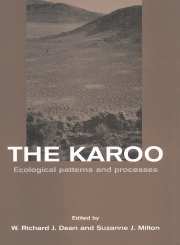Book contents
- Frontmatter
- Contents
- List of contributors
- Foreword
- Preface
- Acknowledgements
- Part one Biogeographic patterns and the driving variables
- 1 The climate of the karoo – a functional approach
- 2 Soils of the arid south-western zone of Africa
- 3 Palaeoenvironments
- 4 Plant biogeography, endemism and diversity
- 5 Biogeography, endemism and diversity of animals in the karoo
- Part two Form and function
- Part three Dynamics
- Part four Human impacts
- Part five Comparisons
- References
- Index
1 - The climate of the karoo – a functional approach
Published online by Cambridge University Press: 23 December 2009
- Frontmatter
- Contents
- List of contributors
- Foreword
- Preface
- Acknowledgements
- Part one Biogeographic patterns and the driving variables
- 1 The climate of the karoo – a functional approach
- 2 Soils of the arid south-western zone of Africa
- 3 Palaeoenvironments
- 4 Plant biogeography, endemism and diversity
- 5 Biogeography, endemism and diversity of animals in the karoo
- Part two Form and function
- Part three Dynamics
- Part four Human impacts
- Part five Comparisons
- References
- Index
Summary
Introduction
The arid lands of southern Africa occupy the area west of approximately 27 °E and north of 34 °S. North of approximately 27 °S, the arid zone becomes confined to coastal belt and plateau of southern Namibia. North of 22 °S, this zone is confined to the hyper-arid coastal belt of the Namib Desert and stretches as far north as 12 °S in southern Angola. The climate is dominated by, and indeed, the aridity is largely caused by, the southern subtropical highpressure (anticyclone) belt. To the south, the region is influenced by the circumpolar westerly airstream (Schulze, 1965). Only the southern and south-western arid regions are influenced by this belt of temperate cyclones. Local modifications occur as a result of the Cape Fold Mountains in the south, the mountains of the Great Escarpment, the raised interior plateau and the cold, north-flowing Benguela current that washes the west coast of the subcontinent. Incursions of moisture into the region are associated with the advection of air across the warm Indian Ocean (maximum precipitation from this source is largely confined to the eastern parts of the subcontinent) and the circumpolar westerlies to the south. Southern African arid lands are geographically marginal to these rain-producing systems.
The first part of this chapter provides an overview of the contemporary climate of the region. The second part provides a description of the weather systems that influence the karoo. This approach is taken to highlight the great diversity of systems that are responsible for the varied karoo climates, something which has not been appreciated by earlier reviews.
- Type
- Chapter
- Information
- The KarooEcological Patterns and Processes, pp. 3 - 16Publisher: Cambridge University PressPrint publication year: 1999
- 42
- Cited by



